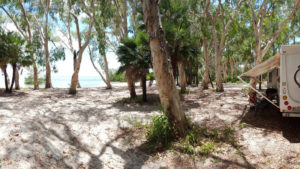Camp Ovens
The campfire is more than just something to stare at during a pregnant pause in the conversation, and a prop for that favourite and constant camping quote “It doesnt get much better than this”. The campfire is also the engine room of the esteemed camp cook. Cooking with the camp fire is one of campings great joys, but like most skills that’s only if your confident, and with a bit of practice and experimentation that confidence is closer than you think.
Anyone can roll a few sausages over a campfire, but its difficult to maintain an interesting diet eating sausages in bread 3 times a day; eventually you’ll run out of bread. (Which we also have a solution for down the page). The campfire can provide a source for all your cooking needs from preparation through to cleaning up. The fry pan and the humble camp oven are the centre pieces of any camp fire kitchen
Like most campers we started out with a couple of cast iron camp ovens. Looking back I should have bought Furphy camp ovens, but the cost frightened a young man and I sadly opted for Chinese knockoffs. I could of course buy Furphys now but the cost and the added “heritage tax” frightens me more now. The Chinese knock off ovens have been faithful companions for over 35 years. Cast iron is of course very heavy, and a little brittle. A handful of years ago we decided to try out a Bedourie camp. The Bedourie camp oven is a heavy gauge carbon steel, but comparatively light weight spun steel camp oven option which originated in Bedourie QLD in the early 1900’s as a lighter and sturdier alternative for cattle drovers.
Temperature is the key to any cooking and camp ovens have the added disadvantage of the absence of knobs, thermocontrol and automation. Camp ovens use coals and not flame, and temperature control is a bit of an art form.
The quality of the coals required is very important. The longer a fire has been burning, the better and more extensive the coals will be, and the longer they will stay viable away from the fire. The amount of coals required is a less than we might initially think. The image below is a boneless beef roast in the Bedourie, and there are an equal amount coals top and bottom. The internal temperature of the camp oven in the below image was around 190deg, and that temperature was obtained (and maintained) with the handful of coals visible on top, and a similar quality of coals placed under the camp oven. We are of course aiming for the same recommended temperatures we use in our home oven.
Important considerations using a spun steel camp oven over a cast iron are hot spots and heat retention. Cast iron will spread and retain heat much better than spun steel. Hot spots are a bigger issue at the bottom because the food is generally closer to the bottom of the camp oven than the top so depending on what we are cooking we spread the bottom coals more toward the edge of the camp oven to reduce the potential for hotspots.
Warm fresh bread is an absolute camp ground gold medal winner, which is difficult to beat lathered in butter and jam. I don’t do damper, because its only one step and some labour from bread and I much prefer bread. When baking bread, the shape will have firmed up and stabilised in the first 20 or so minutes of the cooking process, the bread can then be checked, if necessary removed, and the coals adjusted accordingly. With the loaf in the below image the top was browning off nicely but the bottom was a little slow so we simply removed the coals from the lid entirely to finish the baking. Bread is cooked when it looks cooked, and when it sounds hollow when tapped or knuckle knocked.
The Pepsi cans in the camp oven image below aren’t some secret family trick, they’re just to give the lid clearance to allow the bread to rise. We’ve now retired those Pepsi cans and replaced them with 3 x metal brackets we made up to clip onto the edge of the camp oven and provide an extra 30mm clearance when required
All camp ovens need a trivet in the base to stop whats cooking inside from frying, or burning on the bottom. Camp oven trivets are readily available where camp ovens are sold, but there are other options. Our cast iron camp oven’s trivet is a chrome fruit basket, which has been in the camp oven for 35 years and allows the whole contents to be removed at the same time. For the Bedourie we opted for an upside down $6 perforated pizza tray from Woolworths. The pizza tray is about 5mm to large but is easily flattened around the edge with a hammer to fit by sitting it over a piece of framing timber, kneeling on the timber and tapping the tray around the entire edge to flatten it just enough to fit. A couple of pieces of wire on opposite sides helps to be able remove the trivet when its hot.
The lid of the Bedourie camp oven doubles as a frypan. We have made a gravity handle to effectively turn the lid into a larger replacement of the spun high carbon frypan we used to carry for camp fire cooking. The Bedourie ticks off the big 3 caravanning considerations; weight reduction, storage efficiency and dual purpose for every item.
The camp oven can also be used to make pizzas, and in this location it screamed Hawaiian in a loud voice. We totally missed that Capt Obvious until looking at the pics writing this article
The complete package with home made pizza bases










